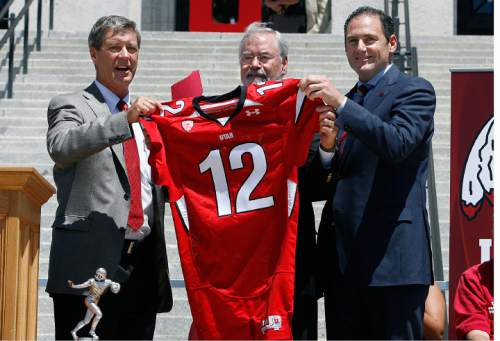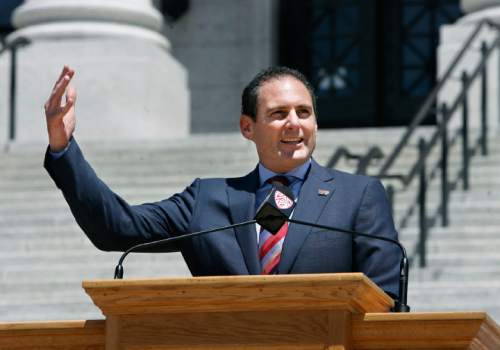This is an archived article that was published on sltrib.com in 2015, and information in the article may be outdated. It is provided only for personal research purposes and may not be reprinted.
They wanted to do something different, something that hadn't been done before.
When the Pac-12 schools launched a seven-channel network in 2012 on its own — without partnering with another network — the sports world was captivated. With commissioner Larry Scott leading the charge, the Pac-12 appeared on its way to putting all of its sports on televisions across the country with total ownership and control.
At the time, Pac-12 officials used the term "from scratch" with hard-won pride.
Less than three years later, the Pac-12's from-scratch formula appears to mean the conference will be trailing the other power leagues it is constantly seeking to catch up to in viewership and in revenue. Scott — and the league at large — remains stoic and confident in what he started, but even he acknowledges the conference has a way to go to fulfill its initial promise.
"We are developing the way we hoped, but we still have a way to go to reach the full potential of our networks," he told The Salt Lake Tribune on Friday. "We certainly realized it takes time to build, and we went in with eyes wide open."
Recent media reports have cast hooks into the Pac-12 Network. While it is technically available in 60 million homes — which the conference trumpets, along with its online viewing options — the San Jose Mercury News reported that 11 million homes receive it, while a Fox Sports report estimated 12.3 million.
That number is dwarfed by SEC Network and Big Ten Network, each estimated at well-over 60 million paying subscribers. The difference? The SEC partnered with ESPN, and the Big Ten's network is run by Fox.
Though it doesn't have to submit to a network overlord and gets back every dime of network profit, the Pac-12's earnings won't compare to the SEC's and Big Ten's projected hauls. While the league's federal tax returns showed earnings of $374 million for the 2013-14 fiscal year — which led all conferences — the SEC Network's launch last fall and the Big Ten's upcoming new deal are estimated to clear over $33 million in television revenue for each of the schools in those conferences, according to the Mercury News.
The bulk of the Pac-12's TV revenue comes from a 12-year rights deal with Fox and ESPN that earned more than $21 million per school last year. Each Pac-12 school $1 million last year from the Pac-12 Network, which is a smaller return than was once hoped, Utah athletic director Chris Hill said during a recent roundtable discussion with Salt Lake media.
"I know it's going to be reevaluated by our presidents to see if the model's working," he said last month. "I think they're taking a look at the landscape and see if we should stick with the model, or should we move on. It could be anything from sticking with where we are, which has some real advantages, to moving in another direction."
A huge sticking point has been the Pac-12's standoff with DirecTV, which doesn't carry the network but provides the others. SNL Kagan analyst Adam Gajo said that's a reflection of not having the leverage of a big network brokering the deal, which many in the industry anticipated when the Pac-12 Network launched.
DirecTV wants to offer the Pac-12 Networks as an ala carte option to its customers, which wouldn't stretch the carriage or generate the revenue the conference envisions. The Pac-12's imprint is mostly on the West Coast, as opposed to the population-heavy markets of the Big 10 and SEC. But the conference's stance is simple: Why should we be treated any differently?
"That's not the way the industry works right now, and the Pac-12 doesn't want to open that can of worms," Gajo said. "They don't want to be the oddball in the mix."
What is the value of independence? Freedom to choose the programming.
Pac-12 Network subscribers can access any number of sports offerings around the clock, including gymnastics, baseball, volleyball and other nonrevenue-generating sports. While many viewers might keep clicking the remote, athletic departments see great value in broadcasting all of the conference's sports, regardless of their commercial appeal.
"The exposure has been incredible for our teams that were not being covered very extensively," said Oregon athletics official Craig Pintens, who serves as the school's liaison to the Pac-12 Network. "Now when our coaches are out recruiting they can tell parents they'll able to watch their son or daughter compete."
There may soon come a point when the Pac-12 reaches a crossroads. Schools will begin to pay cost-of-attendance stipends in the fall, which is expected to add more than $1 million in costs to their respective ledgers. Increased concerns over missed class time have led Scott to ask schools to use charter flights on more trips. Many schools are looking into or have already started providing medical coverage for student-athletes after they graduate.
All of it costs money. Every drop of revenue is important, and if Pac-12 schools are falling millions short of what SEC and Big 10 institutions are getting, that might fuel discussion, or at least exploration, of a new model.
Scott would argue with those projections, though. Citing the Mercury News report, Scott said he foresees more revenue for the Pac-12 than has been reported. He also makes the point that when he took over, the conference had a ton of ground to cover: It has gone from the fifth most lucrative conference to "tied with the SEC for second." The ESPN/Fox deal will also continue to gain value until the end of current terms in 2024.
The conference is also hopeful that when AT&T acquires DirecTV — which The Wall Street Journal reported should move ahead soon, pending federal approval — it will have friendly faces from a corporate partner sitting across the negotiating table. Getting on the satellite provider would go a long way to spreading the brand.
The highly lauded quality of the Pac-12 Network gives Scott confidence: Every year, the network's programming and talent earn a few Sports Emmy nominations. There's a general consensus in the industry that the production value is high, and Scott said no one produces sports content, which includes about 850 live events per year, as efficiently as the Pac-12 does.
With time, he believes, more people will get to see it.
"We've got a lot of optionality and flexibility to consider different models, if we choose to do that at some stage," he said. "I think we were prescient. The world of media has changed dramatically, and to have options that other conferences don't have is an enviable position to be in."
Eventually, that option may be to find a partner, as other conferences have done. But for now — and the foreseeable future — the Pac-12 continues its journey on its own. And the sports television business continues to watch with interest.
"Time will tell," Gajo said. "They're still holding onto 100 percent ownership, and they say that flexibility will help them down the road. Right now, when you look at the numbers from other networks, they tell a different story."
Twitter: @kylegoon —
Television revenue per school, by conference
The Pac-12 pays the second most of any conference in the nation, thanks to the Pac-12 Network and its deal with Fox and ESPN. But with the SEC Network's launch and a new deal beginning in 2017, that likely will change.
2013-14, reported by USA Today:
• Pac-12: $21.2 million
• Big Ten: $27.6 million
• SEC: $20.9 million
Projected figures in 2017-18, by SNL Kagan, as reported by the San Jose Mercury News:
• Pac-12: $22.95 million
• Big Ten: $33 million
• SEC: $35.6 million







